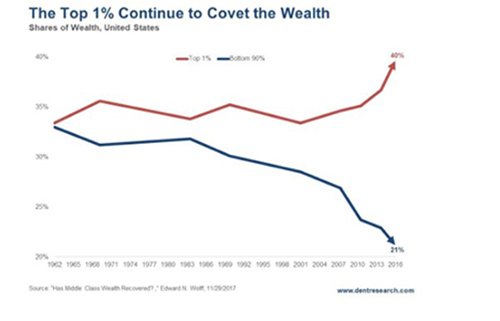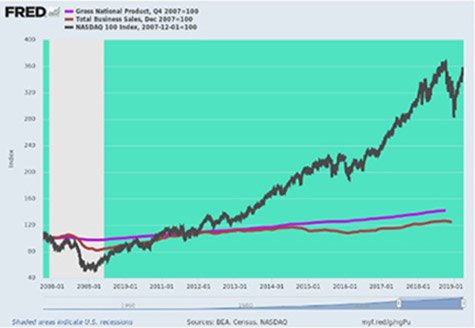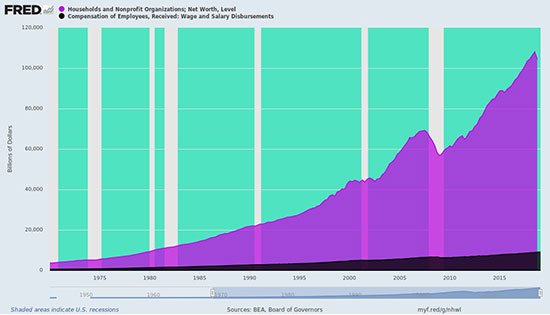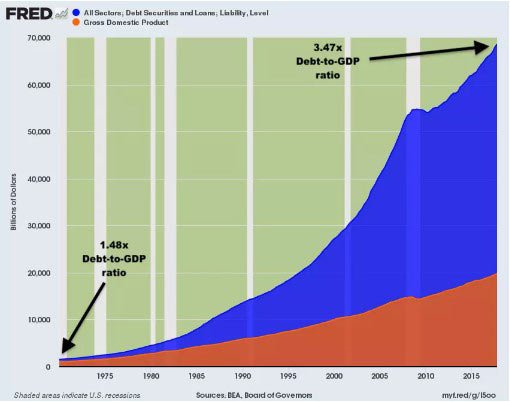I entered the corridors of Wall Street as a twentysomething greenhorn in the late 1990s.
I had a mentor at a big hedge fund on Lexington Avenue, who told me if you can't explain even the most complex markets with "a few graphs and a crayon," then you aren't serving your clients.
Most of our clients, many of whom made their fortunes outside of the trading pits, didn't have the time or patience to be impressed by financial "Masters of the Universe"-types spewing out fancy acronyms and bragging about the latest "arbitrage play" in some asset-backed security packaged by a Big Six bank.
Instead, clients wanted to see the big picture, the current picture, to better understand the probabilities of the future picture in common-sense clarity.
Such blunt speak appeals to instinct and sanity.
More importantly, it can mean the difference between keeping and growing your wealth in the worst of times, or losing everything.
And because every investor - not just the ultra-high net worth folks - deserves that same respect and that same actionable money-making, capital-preserving intelligence, I've gathered up some charts that show "with a few graphs and some crayon," the sheer size and full financial impact of what's about to happen here.
Make no mistake: The pros I know from my days managing money on Wall Street know this is coming.
You should, as well...
[mmpazkzone name="in-story" network="9794" site="307044" id="137008" type="4"]
America Is Addicted to the Very Debt That's Killing It
Much has been made of the recent yield curve inversion that sent markets tumbling and talking heads chattering.
And it's true: Flat or inverted yield curves are one way to predict economic recessions. As rates fall and flatten (or even invert) on the long end of the bond duration X-axis, lenders see little upside in making loans, and thus credit issuance - the very heartbeat of an otherwise zombie business cycle - dries up.
YOU KNOW IT IN YOUR GUT: Look at how things are going. Financial turmoil is coming just around the corner, maybe just a few months away. Click here...
The market dries up thereafter.
You won't hear this on television ever, but most smart folks don't need a flattening yield curve (or media bubbleheads panicking over it) to know that the real economy is already dying.
If you're seeking proof... Just look around you.
The middle class is all but on its knees. Automobile and student loan defaults are breaking records, and the majority of our population is living off 480 million credit cards and unable to put $1,000 into a savings account.
Meanwhile, the top 1% are buying second homes and third cars as part of the greatest wealth disparity ever seen in the history of capitalism.

Such disparity is a classic sign of trouble ahead. This kind of imbalance has never, throughout history, ended well.
But the real national embarrassment (and risk) is the overall disparity between our rising markets and flat production figures.
The graph below makes this clear, rather than speculative.
Here we see that the Nasdaq-100, up over 250% from its 2007 peak, has been ripping, while business sales (red) and gross national product (blue) have been at stall speed for the same period.

Low rates have allowed corporations on the Nasdaq and other exchanges to borrow like crack addicts to buy back their own stocks and make a long series of bad M&A and leveraged buyout deals.
In short, borrowed money has gone into fat salaries and inflated share prices, not capital improvements.
There's a horrific price to pay for that shortsightedness and greed.
Both "Americas" Are in Deep Debt Trouble
Since 2007, corporate debt in America has more than doubled. Today, we are staring at nearly $15 trillion (with a "t") of total business debt outstanding, the majority of which is "junk-rated."
FEAR... PANIC... MISTAKES... RUIN: Investors likely don't have much time left before chaos strikes, and there's zero margin for error. Click here for details...

In ratio terms, today's unsustainable level of total business debt amounts to 75% of GDP.
Please read that again.
As for individuals - i.e., the "weak" consumer class which Powell apparently just noticed last month - they are literally drowning in debt.
Household net worth today stands at $62 trillion, yet only $17 trillion of that figure (the tiny black stuff below) comes from actual wages.
The remaining $45 trillion (the massive purple below) is debt - a ticking time bomb that'll blow when, not if, interest rates rise.

Again, debt is the skunk in our national wood pile. We are literally being crushed to death under the weight.
As that weight gets too heavy, individuals... then companies.... industries... then segments... entire sectors... and ultimately national economies go broke.
You Must Act Now: America is headed for an economic disaster bigger than anything since the Great Depression. If you lost out when the markets crashed in 2008, then you are going to want to see this special presentation...
It happens slowly at first, and then, like Hemingway's description of poverty, "it happens all at once."
We are seeing this in car loans, of course; we're seeing it in student loan defaults. In the real estate sector too, single-family home sales for January 2019 (607,000) are below where they were when Trump took office in 2017 (617,000), and significantly below where they were at the pre-crisis levels of 1,300,000 in 2005 and 2006.
Stated another way, Main Street's fall is happening slowly, then all at once...
How did this happen? Simple enough...
The Single Most Important Graph You'll Ever See
When you see this, you'll understand where we are and where we're heading.
You see, the Fed has kept rates so low for so long that borrowing and debt has never been higher in the United States.
Combined public and private debt now exceeds $70 trillion.
The following seminal graph makes this painfully clear, and folks, it portends that trouble ahead with zero room for doubt.
That $70 trillion-and-counting figure I mentioned amounts to a staggering 3.5x leverage-to-income ratio.
That's the highest in history.

The fallout from such historic debt-to-income levels will be equally historic - and equally staggering.
I'm not trying to scare you with these facts; I'm not trying to upset you. But I don't want to see you caught "swimming naked at low tide" tomorrow.
Here's Why the "Crash" Hasn't Happened Yet
Jerome Powell and the Fed ultimately caved in to clumsy political pressure; they turned from mild, tentative hawks back to bloodless, accommodative doves.
That's why U.S. markets can likely look forward to another party period without rising rates.
Since 2009, such Fed "accommodation" has a 1:1 success ratio on Wall Street, which always enjoys a debt-induced buzz (and price uptick) whenever the Fed throws a new dose at 'em.
2019 is no different.
The stock buybacks, punch-bowl fun, debt rollovers, and "irrational exuberance" will likely continue for a spell in these rate-suppressed, debt-addicted markets.
But given the debt graph above, markets are partying on a mine field, not a dance floor.
Our debt levels are simply too high, and this market is as doomed as an army fighting on two fronts.
As always, history is a warning.
The Germans lost World War II by 1943, but they kept on fighting for two more years; bombed factories spit out new fighter planes (faster than the Fed spits out cheap debt, at that).
Most of Germany's pilots, however, were already dead. There was no one to fly the new planes, save for young boys with a few weeks' training. Most of them lasted three missions, tops, as the ratio of Allied planes to German pilots was around 1,000:1.
In short, the new guys were doomed long before the white flag of surrender went up.
The very same is true of our markets. We've already crossed the point of no return, doomed to lose.
Our markets live exclusively off Fed support, which is not capitalism, but little more than centralized planning. And just as the Germans had no pilots to fly their shiny new planes, we have no growth to support our shiny high debt levels.
The end is, alas, mathematically inevitable.
There's a Choice: Fly In... or Fly Away
It's up to each investor now to decide how much they want to keep fully invested in a losing war.
Sure, there might be a bit more "glory" to come - maybe even a year or so, but the war of debt we are fighting is a losing one. You can't outrun the math forever.
"Trouble Is Brewing": According to Bloomberg's latest report, America could be heading for an economic disaster that would rival the Great Recession. To see why we believe some of the richest players in the world are preparing for a market collapse, click here.
Do you feel like flying a few more sorties? Or landing someplace safe to wait out the carnage?
The choice is yours, but the smart money - that is, the market "aces" that I know - are largely on the sidelines now and only engage in dogfights with trades and investments they know they can win.
They'll get back - all the way back - into these markets when securities are cheap, safe, and corrected - not inflated, expensive, and dangerous.
It's your call. Your money. Put most of it where it's safe; invest the rest where the odds favor you.
In the meantime, be smart, be patient, and be careful.
The Scary Details the Fed Didn't Reveal
On Feb. 27, Chair Jerome Powell revealed the Fed would raise interest rates.
What he didn't say is that those rate hikes could send the U.S. economy into a tailspin... and very well might lead to the greatest economic collapse since the Great Depression.
If you are not willing to lose everything in another market crash, then click here.
Because it's possible to protect yourself from the coming economic disaster - but you have to act now.
Follow Money Morning on Facebook and Twitter.
About the Author
25-year run as a hedge fund portfolio manager, family office chief investment officer, managing director and general counsel. Internationally recognized expert in credit and equity markets as well as macro risk management.



